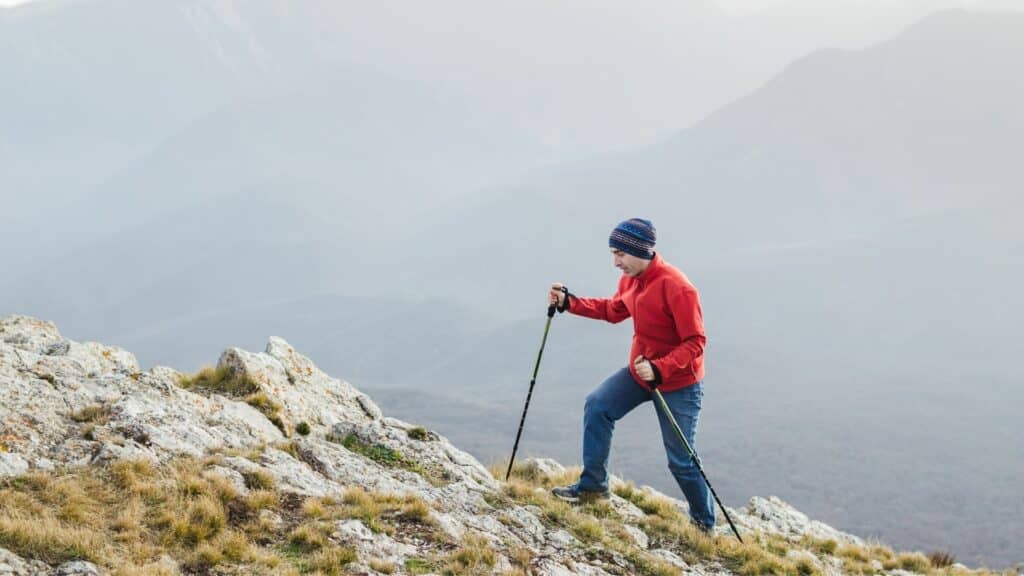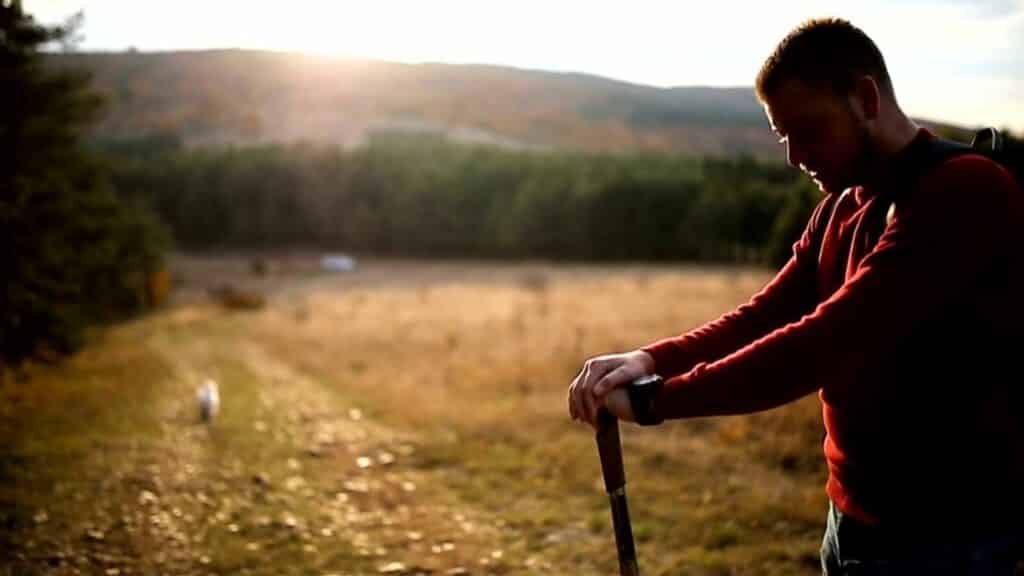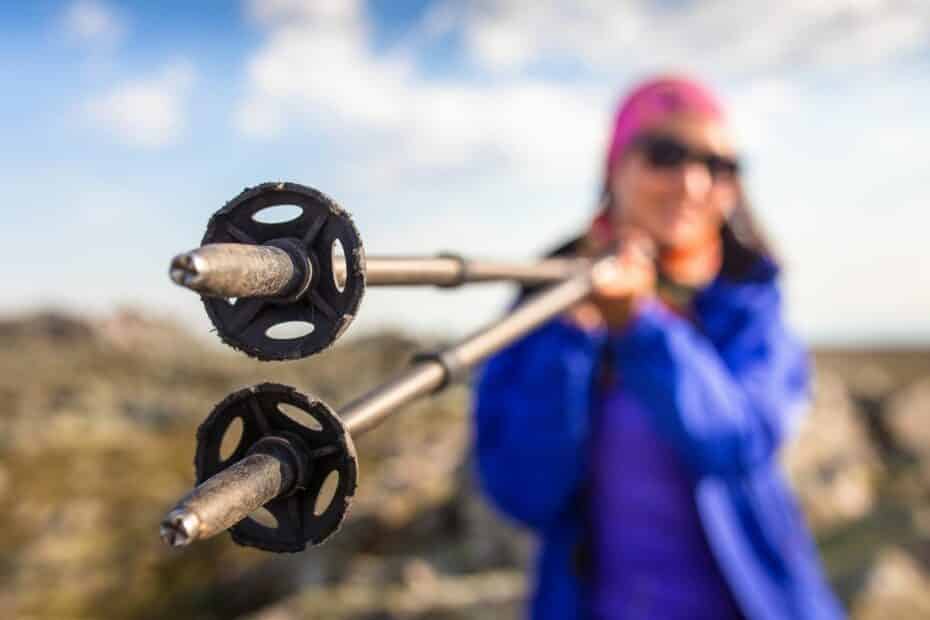Trekking poles are a great way to increase your stability on the trail, take weight off your back, and reduce your risk of injury. Although they’re not a necessity, trekking poles can make a huge difference on long hikes. That leads to a very important decision you will need to make. Should you carry one trekking pole or two?
Use two trekking poles if you’re going on long hikes through technical rocky terrain, slippery trails, crossing rivers, etc. The added stability will reduce your risk of falling, slipping, and getting injured. You can save some weight while maintaining most of the benefits with one pole, but it will reduce stability on difficult terrain.
Whether or not you choose one trekking pole or two depends on personal preference. Getting comfortable with two poles can be a challenge, but I think the added stability and even weight distribution is worth it.
You can still get most of the benefits while using one pole, but it won’t be perfect. It all depends on your personal preference and whether or not you’re willing to carry the additional weight of an extra pole. In the rest of this post I’ll go over a few of the benefits of using one trekking pole vs two.
Table Of Contents
Should I Use One Trekking Pole Or Two?
There’s no one answer to the question of whether you should hike with one trekking pole or two. It depends on your personal preferences and hiking style.
Some people find that using two trekking poles provides more stability and support, particularly on uneven terrain. Others prefer using just one pole, finding it simpler and lighter to carry.
There’s a learning curve to using two trekking poles. Getting used to the asymmetrical walking pattern can be a challenge, but the added stability and stress off your joints is worth it.
If you’re unsure which option is right for you, try experimenting on different hikes. Try out both one and two poles on different terrain, and see what feels best for you. There’s no wrong answer – ultimately, it’s whatever works best for you and helps you enjoy your hike to the fullest!
Benefits Of Using Two Trekking Poles:
- More stability on uneven terrain
- Helps distribute weight more evenly
- Allows you to cover more ground more quickly
Benefits Of Using One Trekking Pole:
- Easier to carry and pack a single pole.
- Generally lighter weight to carry one pole. This is great for short hikes when you’re unsure of the terrain.
- Can be used for other things (like setting up a tarp) even if you don’t want to use your poles.
Which Option Is Right For You?
So, which is the right choice for you? If you’re just starting out, one trekking pole may be a good option. You can always add a second one later if you find that you need it.
One trekking pole is more than enough support on short hikes through well manicured trails. Carrying a second pole is nice, but it’s not entirely necessary.
If you’re covering a lot of ground or hiking in particularly rugged terrain, two trekking poles may be the way to go. I also prefer two trekking poles when I’m carrying a heavy pack or hiking up/down massive hills.
Spreading your pack weight over your entire body and the reduced impact on your joints will make a huge difference on long hikes. Ultimately, it’s up to you to decide what works best for your individual needs.
Whether you choose to use one or two trekking poles, be sure to practice using them before taking them on a hike. This way, you can get used to the feel of the poles and how they can help you maintain balance on uneven terrain.
How To Use Two Trekking Poles

If you do decide to use two trekking poles, there are a few things to keep in mind.
- Make Sure The Poles Are Equal Lengths: First, make sure that both poles are the same length. This will help ensure that they offer the same level of support.
- Adjusting The Poles: On flat ground, you’ll want to keep the poles shorter at a 90° angle with the ground. When going uphill, you’ll want to shorten the poles, and on downhill sections, you’ll again want to lengthen the poles.
- Use Your Wrist Straps: Next, be sure to use the wrist straps. This will help keep the poles from getting away from you if you happen to lose your grip and help transfer your pack/body weight into the poles.
- Tuck Your Arms: When using two trekking poles, it’s important to keep your arms close to your body. This will help you maintain balance and prevent the poles from getting tangled.
- Move Asymmetrically: This means that when one arm is forward, the other should be back. This helps distribute your weight more evenly and makes it easier to hike for long periods of time.
I’ll go over a few of these topics further at the bottom. They can be applied to using a single pole as well, so I’ll cover how to use a single trekking pole first.
Using One Trekking Pole

Using one trekking pole is fairly straightforward. Follow all of the adjustment and usage tips above, but you won’t have to walk asymmetrically with the poles.
Learning how to walk comfortably with two trekking poles can be a challenge. It will take a while to learn how to properly alternate your poles as you walk.
So switching down to one pole takes most of the learning curve away. You get most of the benefits of using trekking poles without any of the issues.
Adjusting The Height Of Your Trekking Poles
Trekking poles are a great way to add stability and support while hiking, but they’re only effective if they’re properly adjusted to your individual height. Most trekking poles have telescoping poles (some are fixed) that can be extended or retracted to accommodate different heights.
To adjust your trekking poles, start by extending or retracting the handle until it’s at a comfortable height for you. Once the handle is in place, tighten the locking mechanisms throughout the pole to secure it in place.
I recommend, adjusting the length of the pole so your elbow forms a 90-degree angle. This is typically between 41-45 inches (105-115cm) for most people.
If you’re still having trouble getting your trekking poles adjusted correctly, don’t hesitate to ask a salesperson or fellow hiker for help. With a little bit of practice, you’ll be a pro in no time!
How To Use Trekking Pole Wrist Straps
Trekking pole wrist straps are an essential piece of equipment. Wrist straps provide added stability, and comfort while hiking. They also help absorb some of the impact and distribute the pack weight across your body.
To use trekking pole wrist straps, simply thread the strap through the loop on your trekking pole handle, and then wrap it around your wrist. There’s a right and wrong way to put your wrists in the strap so watch the video above for more info.
Some trekking pole wrist straps have an adjustable length, so you can customize the fit. Others are one-size-fits-all. There isn’t much of a difference between the two styles so pick whichever style fits your budget.
Once you have your wrist straps in place, make sure they’re tight enough to provide security but not so tight that they’re uncomfortable. You should be able to easily slide your hand in and out of the strap, but it shouldn’t be loose enough to fall off.
Adjust The Height Of Your Trekking Poles When Going Uphill
Trekking poles are a great way to add stability and support while hiking, but they’re only effective if they’re properly adjusted to your individual height. Most trekking poles have adjustable handles that can be extended or retracted to accommodate different heights.
To adjust your trekking poles when going uphill, start by extending or retracting the handle until it’s at a comfortable height for you. Once the handle is in place, tighten the locking mechanism to secure it in place.
Just like walking on flat ground, adjust the poles so your elbow form a 90-degree angle when holding the handle. Since you’re hiking uphill that means you need to shorten the length of the pole to accommodate the incline.
How To Use Trekking Poles When Going Downhill
Use the opposite approach when hiking downhill. You will need to lengthen the poles a little bit so to form the 90° angle. I usually like to increase the angle a little bit so the poles are longer, but that’s up to you.
This is probably a personal thing, but longer poles seem to help take some weight off my knees. It also helps take stress off my calves which makes a huge difference on long hikes.
Whether you choose to use one or two trekking poles, be sure to practice using them before taking them on a hike. This way, you can get used to the feel of the poles and how they can help you maintain balance on uneven terrain.




